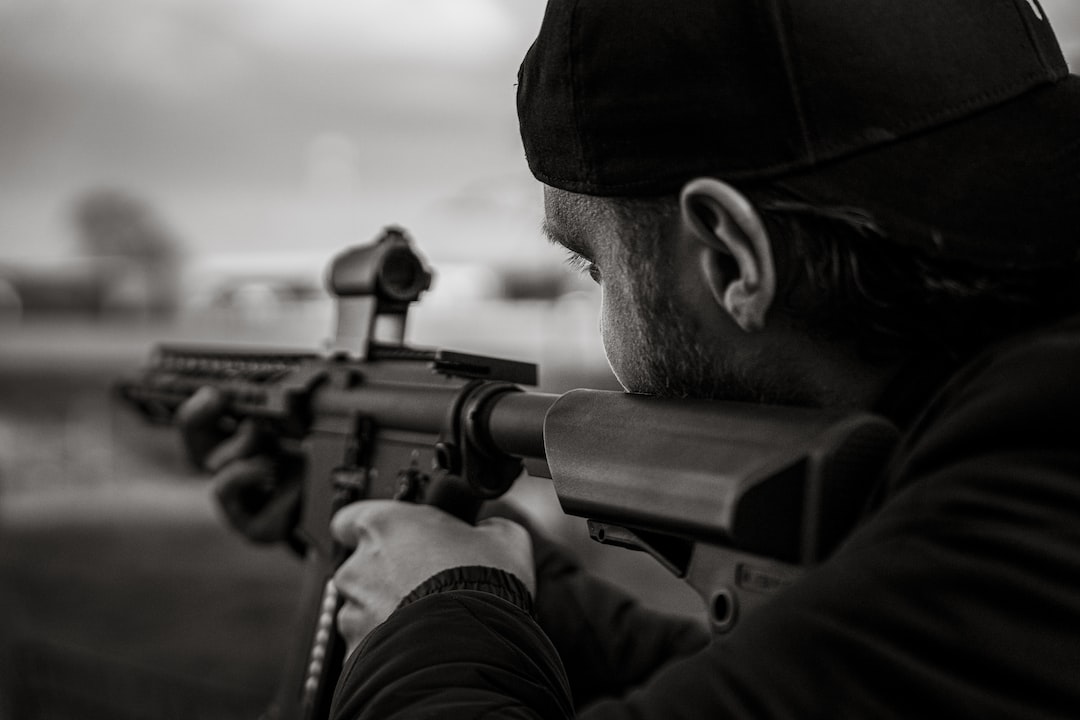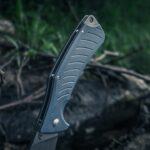Thermal scopes are becoming increasingly popular with hunters and sportsman, but there’s a lot of confusion about how they work, if they’re legal to use while hunting, and what kind of cost range you can expect.
This blog post will discuss all this and more – from comparing night vision goggles vs. thermal scopes to tips on choosing the right one for your needs – so that you can make an informed decision when it comes time to purchase the best thermal scope for your outdoor recreation adventures.
What is a Thermal Scope?
Thermal scopes are a type of advanced optics technology that uses infrared radiation to detect the heat emitted by objects.
Thermal scopes are employed for a range of purposes, including hunting, surveillance and search-and-rescue missions; enabling users to detect heat signatures in darkness or foggy conditions where traditional night vision optics may not be effective.
They allow users to see in complete darkness or foggy conditions where traditional night vision devices may not be effective.
Definition of a Thermal Scope:
A thermal scope is an imaging device that detects the infrared energy (heat) emitted from objects in its field of view and displays it as visible images on a display screen. It works by detecting differences in temperature between objects within its range, allowing you to “see” even when there is no light available.
How Does it Work?
Thermal scopes use special sensors called bolometers which detect the infrared radiation given off by warm bodies such as animals or humans and convert them into electrical signals which can then be displayed on a monitor or other viewing device.
The image produced is usually black-and-white but some models offer color options as well.
Thermal scopes have a major benefit of being able to work in low visibility environments such as foggy weather or total darkness without needing any additional lighting source like flashlights or spotlights. This makes them ideal for hunters who need to track game at night without alerting them with bright lights or loud noises from regular hunting equipment like riflescopes with built-in illuminators.
Additionally, thermal scopes have longer detection ranges than traditional night vision devices so they can help you identify targets at greater distances while still maintaining accuracy and clarity when looking through the scope itself.
Thermal scopes are an incredibly useful tool for hunters, providing enhanced visibility in low-light and no-light conditions. Best paired with a bipod so the thermal scope is steady and will read more accurately.
Before investing in a thermal scope for hunting, it is essential to be aware of any and all rules imposed by state, federal, and local regulations concerning their use. Next, let’s delve into the complexities of understanding and adhering to state, federal, and local regulations concerning thermal scope usage for hunting.
Are Thermal Scopes Legal to Hunt With?
Are Thermal Scopes Legal to Hunt With? It’s a question that many hunters ask, and the answer depends on where you live. Before investing in a thermal scope, it’s vital to be aware of the legalities that apply where you live, such as any state or federal laws.
States may have varied regulations regarding the usage of thermal scopes while hunting. Some jurisdictions allow the use of thermal scopes for hunting, while others do not.
For example, Texas allows hunters to use thermal scopes for night hunting under certain conditions such as using an artificial light source and having permission from landowner or leaseholder before using one.
Other states like New York have more stringent rules when it comes to thermal scope usage during nighttime hunts with restrictions including no shooting within 500 feet of a dwelling or other building without written permission from owner/occupant. Be sure to check your state’s specific laws before purchasing a thermal scope for hunting purposes.
Federal law does not explicitly state whether thermal scopes are legal for hunting purposes; however, there are some general guidelines that should be followed when using them in national parks and wildlife refuges across the country.
It is essential to remember that any relevant state and local laws must be strictly observed, regardless of whether you are within or outside park limits – including all regulations associated with night vision technology such as infrared lights used in combination with thermal scopes, which may not be allowed depending on the region (e.g., National Parks).
Additionally, most federal lands require permits prior to entering so make sure you have one if needed before taking your hunt into these areas.
In conclusion, thermal scopes can be a great tool for hunting if you understand the local, state and federal regulations. Before deciding to acquire a thermal scope, it is essential to take into account the cost and range of quality characteristics offered in today’s market so as to get optimal value for your money.
Cost and Quality Considerations When Buying a Thermal Scope
When considering the acquisition of a thermal scope, various factors concerning cost and quality must be evaluated. Whether you’re looking for an affordable option or something more expensive, there are certain features that should be looked at when making your purchase.
Affordable vs Expensive Options:
When it comes to finding the right thermal scope for your needs, budget is often one of the biggest factors in determining which model will work best for you. While some models can be quite pricey, there are also plenty of options available on the market today that offer great value without breaking the bank.
Before deciding on a cost, it’s essential to contemplate the characteristics you require from your scope; this will aid in limiting your search and ensuring that you acquire precisely what you need.
When searching for a thermal scope, it is essential to consider certain quality features such as image clarity, battery life, field of view (FOV), magnification power and reticle type. Image clarity will determine how clear objects appear through the lens while FOV refers to the area that can be seen through the lens at any given time.
Battery life should also be taken into account since most scopes require regular charging in order to stay powered up during extended hunting trips.
Magnification power determines how close objects appear when viewed through the lens and reticle type indicates different types of aiming systems used by various scopes including crosshairs or circles with dots inside them which make targeting easier from longer distances away from targets. This is similar to the magnification in hunting binos.
When it comes to purchasing a thermal scope, cost and quality are key considerations. Yet another factor to consider when choosing between night vision goggles and a thermal scope is which technology best meets your requirements. In this section we will explore both options in more detail.
Comparing Night Vision Goggles and Thermal Scopes
Hunters and outdoors aficionados often turn to night vision goggles or thermal scopes for their viewing needs, both offering distinct benefits. Both offer distinct benefits for spotting your prey, yet there are distinctions to take into account when selecting which is suitable.
Advantages and Disadvantages of Night Vision Goggles vs. Thermal Scopes:
Night vision goggles use infrared light to amplify existing light in dark environments, allowing you to see clearly even in complete darkness. They are relatively inexpensive compared to thermal scopes, making them an attractive option for budget-conscious shoppers.
Nevertheless, night vision goggles do not perform satisfactorily in foggy or misty conditions as the infrared radiation is easily diffused by minute water droplets present in the atmosphere.
On the other hand, thermal scopes detect heat signatures from objects rather than visible light, so they work well even in foggy or misty conditions where night vision goggles would fail. Thermal scopes, owing to their intricate technology and necessary components for optimal functioning, tend to be pricier than night vision goggles.
No single answer is applicable when it comes to night vision and thermal technology; selecting the right option necessitates a tailored approach. It’s crucial to assess your specific requirements prior to purchasing, so let us now look at some advice for selecting the optimal thermal scope for you.
Tips for Choosing the Right Thermal Scope for Your Needs
When selecting the ideal thermal scope for your requirements, there are some points to bear in mind.
To start, it’s important to figure out what exactly you need. Are you requiring a device that offers extended range observation? Do you seek a lightweight, easy-to-transport optic? Or do you need one that can withstand extreme weather conditions?
Once you have identified your specific requirements, it’s time to start researching different brands and models available on the market today. Whether you shoot a 6.5 Creedmoor or a 308, a thermal scope can take your night hunting to the next level.
Investigate feedback from other hunters who’ve utilized various scopes to determine which one may be best for you. You should also take into account any additional features or accessories that come with each model such as night vision capability or image stabilization technology.
When assessing cost and quality, be sure to factor in whether the scope meets all your requirements without causing a financial strain.
Finally, if possible try out different scopes before making a purchase decision so that you can compare them side by side and determine which one works best for your individual hunting style. Despite the possible convenience of trying out various scopes before buying, most stores will not permit customers to do so for safety reasons – thus this option may be unavailable depending on where you shop.
Ultimately, no matter what type of thermal scope fits within your budget or preferences; make sure it meets all of your needs before investing in one.
FAQs in Relation to Best Thermal Scope
Which is the best thermal rifle scope?
The best thermal rifle scope is the ATN Thor 4. This advanced piece of technology offers a range of features, including an HD 640×480 sensor for superior image quality and clarity, ballistic calculator to help you make precise shots, and a smooth zoom capability up to 10x magnification. It boasts Wi-Fi streaming, enabling you to effortlessly broadcast your hunting experience with loved ones.
With its cutting edge technology and user friendly design, the ATN Thor 4 is the ideal choice for any hunter looking for an accurate thermal rifle scope that will provide years of reliable performance in even the most challenging conditions.
What brand thermal scope does the military use?
The U.S. military uses a variety of thermal scopes, depending on the mission and environment they are operating in. One of the most commonly used models is the FLIR Systems ThermoSight Pro Series, which features advanced imaging technology for superior detection and identification capabilities in any light condition or terrain.
This scope utilizes a 640×480 uncooled microbolometer sensor to provide clear imagery with up to 4x digital zoom capability, making it an ideal choice for long-range surveillance operations. The ergonomic construction of the scope makes it straightforward to use and maintain, even in demanding environments.
With its impressive performance and reliability, this thermal scope has become a trusted tool among hunters, sportsman, outdoors enthusiasts and rural communities across the Western United States.
What is the longest range thermal scope?
The longest range thermal scope currently available is the Pulsar Helion XP50 2.5-20x42mm Thermal Imaging Monocular. This advanced thermal imaging device boasts an astonishing detection range of up to two thousand meters, and is outfitted with a high-resolution 640×480 pixel display for supremely sharp visuals at 50 Hz refresh rate.
The integrated video recording capabilities allow users to capture still images or videos in both day and night conditions, making it perfect for hunting applications. The ergonomic build of this unit ensures comfortable use for extended periods, while its IPX7 waterproof rating makes it able to withstand any kind of weather. The Pulsar Helion XP50 is an ideal pick for the serious hunter aiming to up their game, offering remarkable range and cutting-edge features.
Is thermal better than infrared for coyote hunting?
Thermal imaging is generally considered to be better than infrared for coyote hunting. Thermal imaging allows you to detect the heat signature of a coyote, making it easier to spot them in low light conditions or even at night. Additionally, thermal imaging can penetrate fog and smoke more effectively than infrared.
The increased resolution also helps hunters identify their target with greater accuracy and clarity. Ultimately, thermal imaging offers a distinct advantage over traditional infrared when it comes to hunting coyotes.
Conclusion
When selecting a thermal scope, it’s important to evaluate your budget, desired features and whether night vision or thermal optics is most suitable for the hunt. You’ll want to think about how much you’re willing to spend, what features you need, and whether or not night vision goggles or a thermal scope is better suited for your particular hunting situation.
Make sure that whatever thermal scope you choose is legal in your area and remember that higher quality models may cost more but will often provide better performance. With the right research and knowledge of what’s available on the market today, finding the best thermal scope for your needs can be easy.



